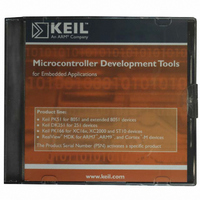MDK-ARM Keil, MDK-ARM Datasheet - Page 65

MDK-ARM
Manufacturer Part Number
MDK-ARM
Description
KIT REALVIEW MCU DEVELOPMENT
Manufacturer
Keil
Type
Compiler and IDEr
Specifications of MDK-ARM
For Use With/related Products
ARM MCUs
Lead Free Status / RoHS Status
Lead free / RoHS Compliant
- Current page: 65 of 156
- Download datasheet (3Mb)
Getting Started: Building Applications with RL-ARM
65
Ethernet and IEEE 802.3
Today’s most dominant networking transport layer for local area networks is
Ethernet (or rather Ethernet II to be exact). The Ethernet header contains a
synchronization preamble, followed by source and destination addresses and a
length field to denote the size of the data packet.
The Ethernet data frame is the transport mechanism for TCP\IP data over a Local
Area Network.
The data in the information field must be between 46 and 1500 octets long. The
final field in the data packed is the Frame Check Sequence, which is a Cyclic
Redundancy Check (CRC). This CRC provides error checking over the packet
from the start of the destination address field to the end of the information field.
TCP/IP Datagrams
In Ethernet networks, the Ethernet data packet is used as the physical
transmission medium and several protocols may be carried in the information
section of the Ethernet packet. For sending and receiving data between nodes,
the information section of the Ethernet packet contains a TCP/IP datagram.
The Layer2 frame (Ethernet) encapsulates the TCP/IP datagrams.
Internet Protocol
The Internet Protocol is the basic transmission datagram of the TCP/IP suite. It
is used to transfer data between two logical IP addresses. On its own, it is a best-
effort delivery system. This means that IP packets may be lost, may arrive out of
sequence, or may be duplicated.
There is no acknowledgement to the sending station and no flow control. The IP
protocol provides the transport mechanism for sending data between two nodes
on a TCP/IP network.
Related parts for MDK-ARM
Image
Part Number
Description
Manufacturer
Datasheet
Request
R

Part Number:
Description:
KIT REALVIEW MCU DEVELOPMENT
Manufacturer:
Keil
Datasheet:

Part Number:
Description:
Development Software SUPPORT EXTENSION FOR MDK-ARM-B
Manufacturer:
Keil Software

Part Number:
Description:
Development Software SUPPORT EXTENSION FOR MDK-ARM
Manufacturer:
Keil Software

Part Number:
Description:
KIT REALVIEW MCU DEVELOPMENT
Manufacturer:
Keil
Datasheet:

Part Number:
Description:
Development Software MCU DEV KIT FOR ARM UPG TO FLOATING LIC
Manufacturer:
Keil Tools

Part Number:
Description:
Development Software MCU DEV KIT FOR ARM W/ FLOATING LICENSE
Manufacturer:
Keil Software

Part Number:
Description:
Development Software MCU DEV KIT FOR ARM uVISION & C++ & RTX
Manufacturer:
Keil Tools

Part Number:
Description:
Development Software SUPP LICENSE RENEWAL 90+ DAYS NO TECH SUP
Manufacturer:
Keil Software
Part Number:
Description:
KEIL C-COMPILER INTERNATIONAL
Manufacturer:
Silicon Laboratories Inc

Part Number:
Description:
BOARD EVAL FOR LPC213X ARM MCU
Manufacturer:
NXP Semiconductors
Datasheet:
Part Number:
Description:
K60N512 Keil Tower Kit
Manufacturer:
Freescale Semiconductor
Datasheet:










